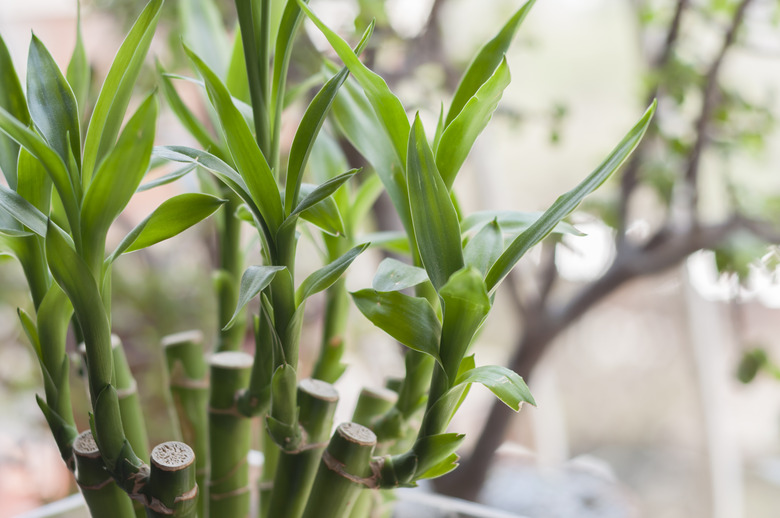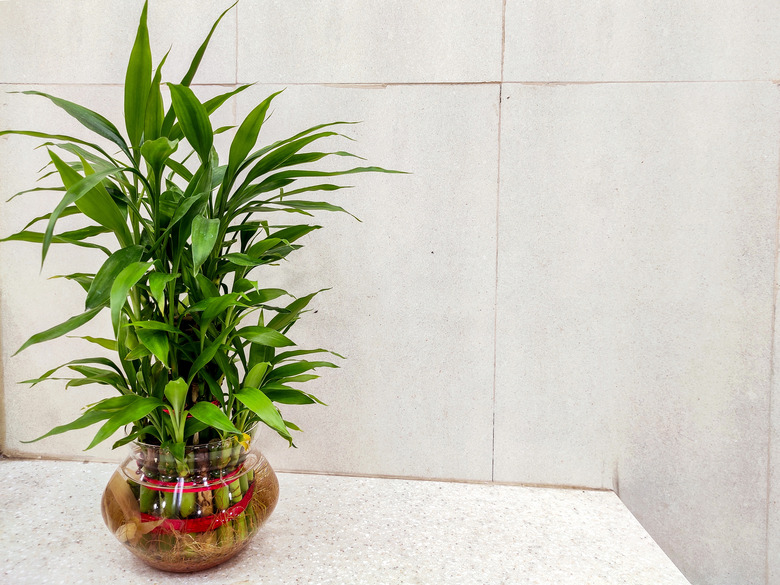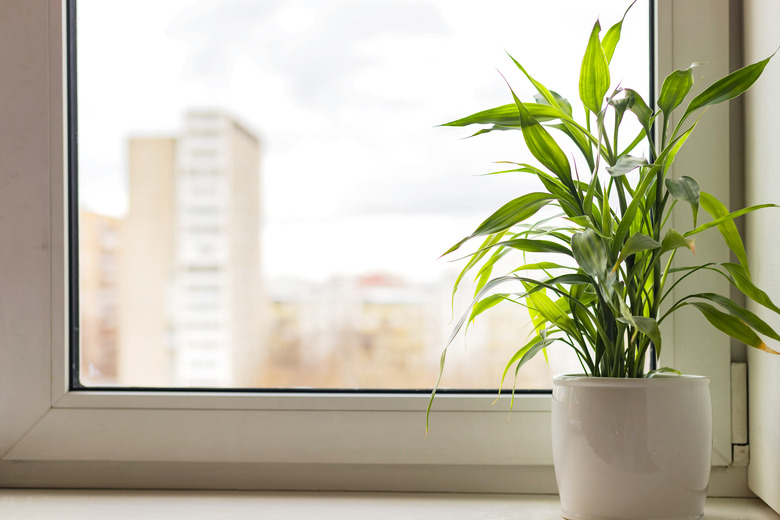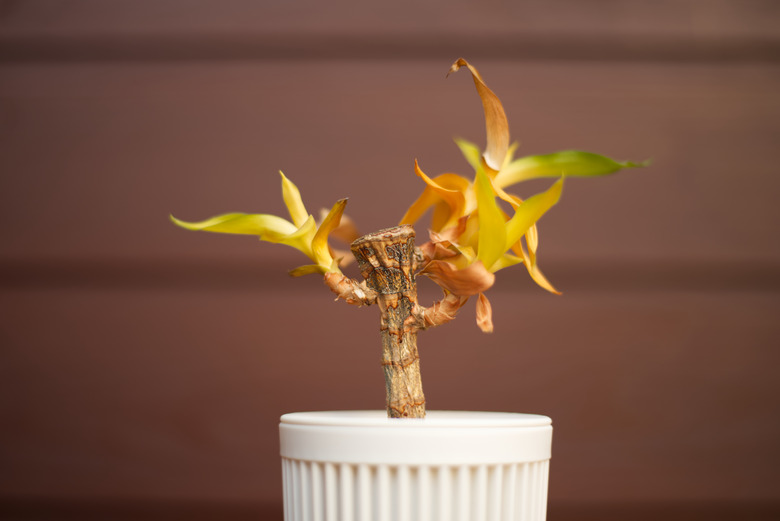How To Care For A Chinese Water Bamboo Plant
Lucky Bamboo as a Houseplant
Sometimes called lucky bamboo, Chinese water bamboo (Dracaena sanderiana) is a low-maintenance plant grown for its lush foliage and structural form. It is typically grown as a houseplant but will also grow outdoors in USDA plant hardiness zones 9 to 12, where it can reach a mature height of 5 feet with a 5-foot spread, although indoor plants rarely reach that size.
Chinese water bamboo plants are well known for tolerating difficult growing conditions and neglect, but they will look much better if provided with regular care. Fortunately, learning the basics of how to take care of a bamboo plant is simple to do and easy to master for beginner and advanced growers alike.
Warning
Chinese water bamboo is highly poisonous to cats and shouldn't be grown in homes where cats live indoors.
Growing Chinese Water Bamboo Plants
Providing the right growing conditions is the first step toward caring for a Chinese water bamboo plant. Sunlight, growing medium and temperature all affect how well the plant will grow, but Chinese water bamboo will adapt to challenging and unusual growing conditions that other plants would not survive, including growing in water.
Growing Chinese Water Bamboo in Soil
Chinese water bamboo grows best in moist, well-draining soil. A clay or plastic pot and standard potting soil work well for growing these tough plants; just be sure to choose a pot with a drainage hole at the base. Avoid very sandy potting soil, which may not hold enough moisture.
Chinese water bamboo needs very bright, indirect light, but strong sun can scorch the foliage. Position the pot within a few feet of an east- or west-facing window. Do not place these plants against an unshaded south-facing window, because the strong sunlight can damage the foliage.
Tip
In warmer climates, place Chinese water bamboo plants in a sheltered location under light shade outdoors. Just be sure to bring them in when temperatures drop below 50°F.
Growing Chinese Water Bamboo in Water
Chinese water bamboo will grow in nothing but water as long as the plant is provided with some structure for its roots.
- Grow Chinese water bamboo in a vase that is at least 3 inches deep. Clear glass works well if you want to watch the roots grow, but some growers opt for an opaque container so that algae growth on the roots is not visible.
- Place a layer of pebbles along the bottom of the vase, which will provide structure to hold the roots. Use colored glass pebbles or natural pebbles, whatever looks best to you.
- Set the Chinese water bamboo pieces in the vase resting on the pebbles. Make sure the foliage points up and the cut end of the bamboo points down.
- Add enough distilled or filtered water to the vase to cover the roots. At least 3 inches of water is needed if the bamboo pieces have not yet sprouted roots. Add more water as needed to keep the roots covered.
Tip
Using tap water with chlorine or fluoride to grow Chinese water bamboo can cause the tips of the leaves to turn brown, so use distilled or filtered water. Rainwater also works well.
Caring for Chinese Water Bamboo Plants
Chinese water bamboo will survive long periods of neglect but will look and grow better if provided with regular care. Caring for these low-maintenance plants is easy, but Chinese water bamboo plant care needs differ depending on whether they are grown in soil or in water.
Caring for Chinese Water Bamboo in Soil
**Water:** Chinese water bamboo will tolerate dry soil for long periods of time, but it is best to water the plants whenever the soil looks dry on the surface. Add water until the soil is fully saturated and the excess water drains from the bottom of the pot.
**Fertilizer:** Fertilizer is not required to grow Chinese water bamboo plants, but they are moderately heavy feeders when grown under bright light. An application of liquid plant food diluted to half strength in spring will support their growth. Do not feed in the autumn and winter months or if the plant is grown in dim light.
**Pruning:** Pruning Chinese water bamboo is only needed to hold back its vertical growth. Simply cut back the plant to the desired size using sharp pruning shears that have been wiped down with disinfectant. Make the cut straight across just above a growth node.
Tip
If you're growing your lucky bamboo in water, be sure to change the water in your growing container every 7 to 10 days.
Caring for Chinese Water Bamboo in Water
**Water:** Change the water in your growing container every 7 to 10 days. Clean the pebbles and the container each time you change out the water, which will help limit algae growth. Be sure to use distilled or filtered water instead of tap water.
**Fertilizer:** Chinese water bamboo in water will grow well without fertilizer, but a drop of fertilizer can be added to the water each month if the plant is growing very slowly. Use a fertilizer formulated for Chinese water bamboo or use a drop of seaweed emulsion.
**Pruning:** Pruning Chinese water bamboo that is growing in water is a good idea, particularly if the plant is becoming top-heavy. Head back the talkest stalk and cut it straight across just above a growth node using sharp pruning shears. Pruning can be done year round, but regrowth is faster in the spring and summer months.
Troubleshooting Chinese Water Bamboo Plants
Chinese water bamboo plants rarely suffer from serious problems unless they are grown under the wrong conditions. Most common troubles stem from low light, soggy soil or using tap water, which can be corrected if caught early.
- If your Chinese water bamboo plant develops brown leaves, try switching to distilled or filtered water for watering and move the plant out of strong, direct light.
- Discolored or shriveled canes can sometimes occur due to wet soil. Let the soil dry out between waterings and prune off the damaged cane at the base using sharp, clean pruning shears.
- Low humidity can also cause issues, so try misting your plant with water if its growing conditions are very dry. Spritzing with water is an especially good idea during the winter months when the heater is running indoors, drying out the air.



